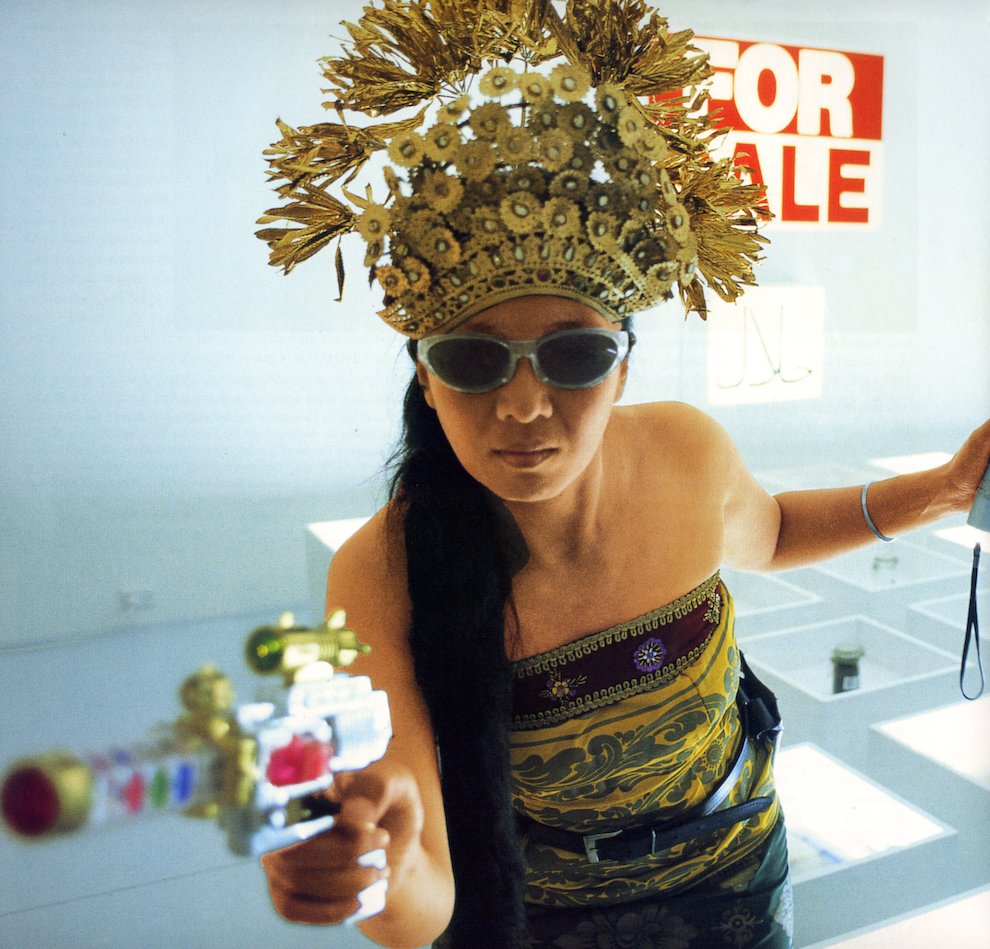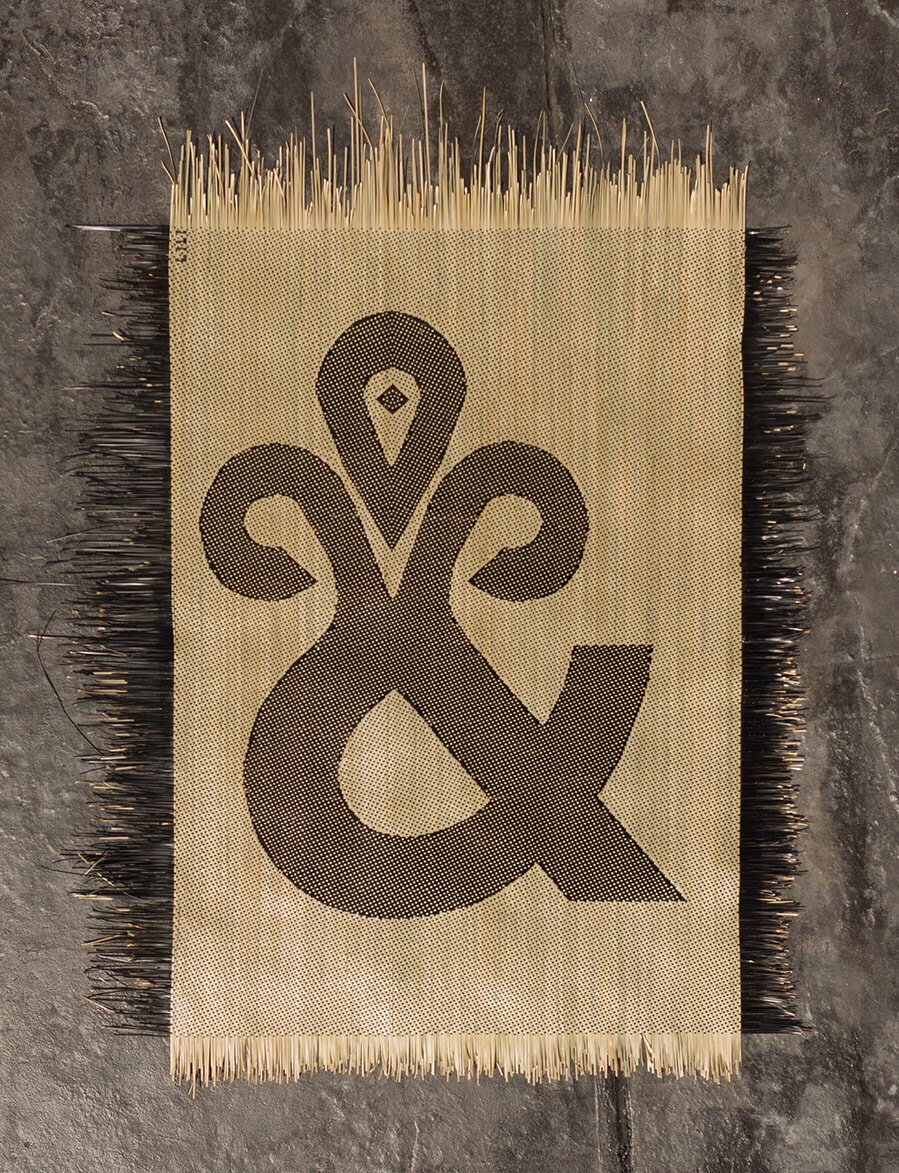Conversation with Swiss-Malaysian artist Olga Titus
On transculturalism, gardens and Dior Lady Art
By Ian Tee
Olga Titus. Photo by Florian Kalotay.
Swiss-Malaysian artist Olga Titus has a playful approach to the question of transculturalism. Working across video, installation and painting, her practice connects elements across different cultures to create new hybrids. Olga is best known for her sequin paintings which have a shifting, screen-like appearance. Much like the rest of her creative output, they occupy what she calls a "fluid space" that is between cultures, as well as the analogue and the digital.
In this conversation, Olga speaks about how her familial background shaped her artistic practice, her Dior Lady Art collaboration, as well as her latest solo exhibition 'Guardians of the Garden'.
Olga Titus, no Title, 2019, digital print on sequins mounted on fleece with wooden frame, 194 x 251 cm. Collection of Kunstmuseum Thurgau. Photo by Stefan Rohner.
I would like to start the conversation by discussing your entry into art. You were an embroidery designer from 1996 to 1999 before transitioning into fine art. What prompted this shift? And how would you describe your art education?
After completing the foundation course in art school, my parents wanted me to first do an apprenticeship before studying art. They thought it would be more responsible to go into a "proper profession”, such as being an embroidery designer. In Switzerland, it is very common for young people to learn a trade through an apprenticeship
However, I already knew that I would want to study art after and did so at the Lucerne School of Arts and Design.
The biographical is an important aspect of your work. Could you talk about your connection with Malaysia?
My connection to Malaysia comes from my father’s side of the family. My grandfather emigrated from Kerala, South India, to Malaysia to become a food inspector when he was a young adult. My grandmother’s family also came from Kerala and she was born in Malaysia. In the 1970s, my father emigrated to Switzerland through what was known as the “Hippie trail”, over land from the East. His goal before entering Europe was to become a chef in a French restaurant but then he ended up in Switzerland with my mum who was a chef! Hence, Malaysia has always been very important to my family. We visit all our relatives there once or twice every year and keep up with the connection.
In Switzerland, I am perceived as a person of colour (PoC). However, in Malaysia, it is the other way round. To them, I am also white, which makes me different so there has always been some kind of gap between the outside world and my family and I.
Depending on where we are, we are perceived differently by different people. Growing up in between cultures and this desire to create connections has a significant impact on me. I love being a hybrid, more than “just” a full Indian, Swiss or Malaysian. We are taught to say we are half this and half that, but I prefer to think we are both or double!
Indian theorist Homi Bhabha’s notion of “the third space” is often cited as a source of inspiration. How has it influenced your outlook and approach to art-making?
For me, Bhabha’s idea is very influential, in that he recognised the presence of this third space and wrote a book about it. Nowadays, there are many texts out there which are borne out of this concept. However, back in 2002 when I was a student and working on this subject, “the third space” was the first theory that resonated with me.
“Growing up in between cultures and this desire to create connections has a significant impact on me. I love being a hybrid, more than “just” a full Indian, Swiss or Malaysian. We are taught to say we are half this and half that, but I prefer to think we are both or double!”
Olga Titus, ‘Tropenkopf’ (video still), 2017, video, 2 min 12s. Image courtesy of the artist.
Zoetrop_der Film.mov from olga titus on Vimeo.
You appear as the central character in video works such as ‘Tropenkopf’ (2017). What was your intention behind this work? And why is it important to use your body or self-image in them?
I play a role in many of my video art pieces, as well as object-based projects too. As my practice is autobiographical, it makes absolute sense to use my own body as a performer. Most of my works speak about the connection between cultures and the creation of a new one that has without boundaries. I also like the gesture of acting, even if it is done in a very amateur way. It adds another level of communication and I can ensure the performance is exactly how I want it to be. By playing the character myself, it also makes the creation process more fun. The viewer can often sense the artist’s expression and their intention for making the work.
The video ‘Tropenkopf’ is based on a German expression which has a racist connotation. It literally translates to mean “head from the tropes” or “Tropical Head”, describing a person from a tropical island. However, it is also used as an expression to mean idiot or douchebag.
This cliché expression has always had a visual association so I created a pot of fruits on top of this female Tropenkopf. She licks a papier-mâché ice cream with a long tongue to the rhythm of Vanilla Ice’s song ‘Ice Ice Baby’. It is a picture of exaggerated cultural stereotypes, made by a person who is trapped by the ways others classify her. When people try to “decorate” me with other elements or clichés in a blurry potpourri mash-up, I see it as a form of cultural appropriation. I think cultural appropriation works both ways, when one takes and uses without permission of other cultures. For me, Vanilla Ice represents one of the first white rappers who made a name for himself through cultural appropriation, whether it was done consciously or unconsciously.
Olga Titus, installation view of solo show at TART Zurich. Photo by Valentina De Pasquale.
Olga Titus, no Title (detail), 2019, digital print on sequins mounted on fleece, 90 x 120 cm. Image courtesy of the artist.
The surfaces of your sequin paintings have an almost “digital” quality which juxtaposes strongly against the notion of craft and hand-work associated with this material. How do you produce this effect? What are the other materials used and techniques/processes involved in making these paintings?
The digital quality was something I discovered after experimenting with this technique and it surprised me as well. I think it is one of the greatest things that can happen during one’s journey as an artist. I figured that the sequins’ effect is like a physical manifestation of the content of my art. It is a “liquid” form, always in movement with no fixed and rigid moment. It is a new space that opens in between these two polarities.
The juxtaposition between the digital and analogue is a very important element in my work generally. The effect created by thousands of sequins makes the painting look overly pixelated. I use still images from my past works as well as found photos as a base for the digital collages. They are then printed onto sequins.
Olga’s studio. Image courtesy of the artist.
Do you have any working habits in the studio?
I have started to do yoga or swimming in the early morning before going to the studio. Also, I believe in taking my time with work, and I have realised that I am much more productive when I am not stressed out. I have liberated myself from restrictive schedules, to live my life and art more in the present moment. It is more important to invest in physical and mental health than to feed negativity or doubt.
Olga’s collaboration with Dior, as part of Dior Lady Art #5. Photo by Florian Kalotay.
Recently, you created three new interpretations of the Lady Dior bag as part of the fifth edition of ‘Dior Lady Art’. Did you approach this commission differently from your own artistic work? Were there moments that surprised you during this collaboration?
It was a similar process as with my own artistic work. Although it is a commission for Dior, the artists are completely free to create on their own terms. The given framework was the shape of the bag itself. It was a close collaboration with designers at Dior, and I am happy that they understood my perspective, concept and style.
“It is funny because the term “moving picture” describes both my digital pieces and work using sequins very well. The connection between pixelation and pointillism is another interesting connection with Impressionism.”
Olga Titus, ‘Guardians of the Garden’, 2021, exhibition view at Helvetia Art Foyer, Basel. Photo by Viktor Kolibàl.
Olga Titus, ‘Guardians of the Garden’, 2021, exhibition view at Helvetia Art Foyer, Basel. Photo by Viktor Kolibàl.
I would like to end the interview discussing your latest solo exhibition ‘Guardians of the Garden’ (2021) at Helvetia Art Foyer, Basel. Tell us more about the exhibition title and how you engaged with the exhibition space, which is a public area within Helvetia’s head office.
‘Guardians of the Garden’ runs until Art Basel week in September. The title references a video ‘Guardians’ which I made for the show. It was produced during our first "Corona winter" last year when my longing for nature became stronger and stronger. Maybe it is an inner protest against digitalisation in our world. It seems to be something that resonates with people recently as other creatives in Switzerland have been referring to the garden as a theme too. The video shows a cosmic garden which reminds one of Impressionist paintings, such as Claude Monet’s waterlily paintings in Giverny.
Contrary to my theme-based videos, which follow a narrative or planned storyboard, this direction of work was set frame by frame. I figured that this is a painting process, where each picture generates the next one. Therefore, at times, I feel like a painter working with digital media to create moving pictures. It is funny because the term “moving picture” describes both my digital pieces and work using sequins very well. The connection between pixelation and pointillism is another interesting connection with Impressionism.
The exhibition space sponsored by Helvetia has high 4-metre ceilings and huge windows. It is important to mention that Helvetia Art Foyer is a non-commercial gallery that supports artists and the company does not profit from the space. The company also has one of Switzerland’s oldest corporate art collections.
Are there any upcoming projects you would like to share?
I would like to highlight my upcoming solo show at Studio West, a new format of Kunsthalle Darmstadt (DE). The exhibition opens in September and I am working on it now. Thank you for the interview!
‘Guardians of the Garden’ is on view at Helvetia Art Foyer, Basel, from 24 June to 30 September 2021. The artist will be present on 22 to 24 September 2021, from 4 to 8pm.

















